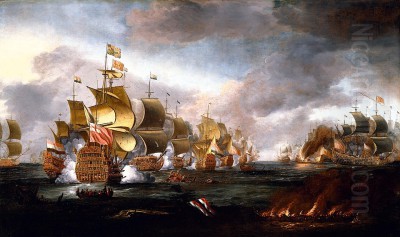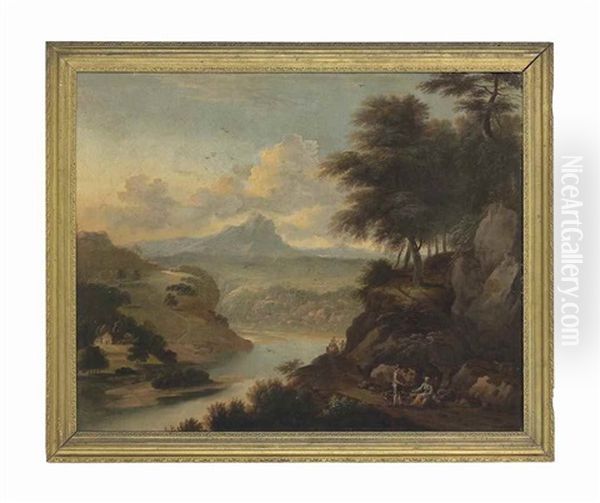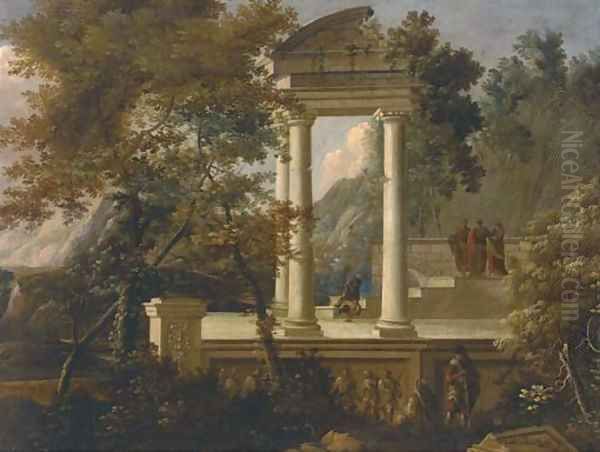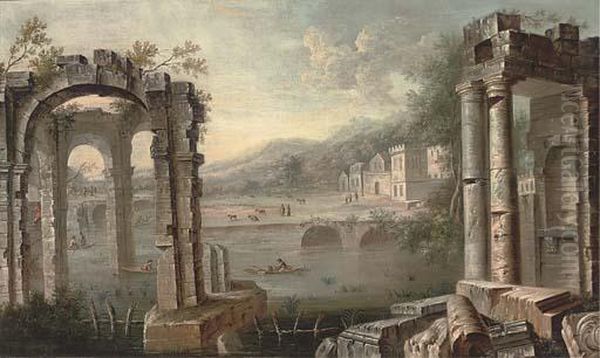
Adriaen van Diest stands as an interesting figure in the transition period of the late Dutch Golden Age, a painter and etcher whose career bridged the artistic environments of The Hague and London. Born into an artistic family, he developed a specialisation in landscape painting, a genre reaching its zenith in his homeland. However, much of his professional life unfolded in England, where he found patronage among the aristocracy. While not always achieving the consistent brilliance of the foremost masters of his time, van Diest produced works of considerable charm and skill, leaving behind a body of landscapes and etchings that reflect both his Dutch training and the tastes of his adopted country. His life and work offer insights into the movement of artists and artistic styles across the North Sea during the latter half of the seventeenth century.
Early Life and Artistic Formation in The Hague
Adriaen van Diest entered the world in The Hague in 1655. His artistic path was perhaps set from birth, as he was the son of the painter Jeronymus van Diest (sometimes referred to as Jeronymus van Diest the Elder). His father was himself an established artist, noted particularly for his marine paintings and coastal scenes, often executed with a sensitivity to atmospheric effects, sometimes employing the subtle, tonal grisaille technique. It was under his father's guidance that Adriaen received his foundational instruction in the art of painting. This initial training would have immersed him in the principles and practices prevalent in the Dutch Republic during a period of extraordinary artistic flourishing.

Beyond his father's workshop, sources suggest Adriaen's education was broader than typical for an aspiring painter of the era. He reportedly studied Latin in Leiden, indicating an intellectual inclination that might have informed his later work. His artistic training was further supplemented by instruction from Simon de Valk, from whom he likely honed his skills in both painting and the intricate art of etching. This combination of paternal instruction and external tutelage provided van Diest with a solid technical grounding. His early environment was rich with artistic stimuli; The Hague, as a centre of government and court life, attracted numerous artists. He would have been aware of the works of leading landscape painters like Jan van Goyen, whose tonal innovations had profoundly impacted the genre, and perhaps the more dramatic compositions of Jacob van Ruisdael.
Relocation to London and Patronage
A pivotal moment in Adriaen van Diest's life occurred around 1672, when, at the young age of approximately seventeen, he relocated to London. This move was part of a larger trend of Dutch and Flemish artists seeking opportunities abroad, particularly in England, which lacked a strong native school of painting comparable to that of the Low Countries. London, especially after the Restoration of the monarchy in 1660, offered potential patronage from the court and the nobility, who were keen to emulate continental tastes in art and decoration.
Soon after his arrival, van Diest found significant employment with John Granville, 1st Earl of Bath (1628–1701). This patronage was crucial for the young artist establishing himself in a new country. For the Earl, van Diest undertook commissions to paint views of the West of England. These works often depicted specific locations, landscapes, and notable ruins within the Earl's sphere of influence or interest. This type of topographical landscape painting was becoming increasingly popular in England, documenting the estates and travels of the landed gentry. Working for a prominent figure like the Earl of Bath provided van Diest not only with financial support but also with visibility among potential future clients within English aristocratic circles.
His presence in London placed him amidst other influential foreign artists who dominated the English art scene. Sir Peter Lely, of German-Dutch origin, was the leading portrait painter until his death in 1680, succeeded by Godfrey Kneller, also from Germany. Marine painting was largely the domain of the Dutch father-and-son duo, Willem van de Velde the Elder and Willem van de Velde the Younger, who had also moved to England. While van Diest focused on landscapes, he operated within this milieu of continental European artists shaping English artistic preferences.
Artistic Style: Landscapes and Etchings

Adriaen van Diest dedicated his career primarily to landscape painting and etching. His style reflects his Dutch roots but also adapted to the demands and tastes he encountered in England. His landscapes often feature expansive views, sometimes with rolling hills, distant mountains, and carefully rendered foliage. There's often an Italianate flavour to his work, a characteristic shared by many Dutch painters of the latter seventeenth century, like Nicolaes Berchem or Jan Both, who incorporated idealized, sunny visions inspired by Italy, even if they hadn't travelled there themselves. This contrasted with the more purely 'native' Dutch landscapes of artists like Meindert Hobbema, known for his intimate woodland scenes.
His brushwork is frequently described as delicate and his handling as light and skillful, particularly in his better works. He could effectively capture atmospheric perspective, rendering the recession of space through subtle gradations of tone and colour. His subjects included pastoral scenes with shepherds and livestock, wooded landscapes with travellers, coastal views, and the topographical scenes commissioned by patrons like the Earl of Bath. He seems to have occasionally painted marine subjects, perhaps influenced by his father, Jeronymus van Diest, and the prevailing interest in sea power, reflected in the mention of a "naval battle painting" associated with him.
Van Diest also practiced etching, producing a number of prints based on his own designs. These etchings are often praised for their "light and masterly" quality, showcasing his skill in handling the etching needle to create fine lines and tonal variations. While perhaps less numerous than his paintings, his etchings are considered a valuable part of his output, demonstrating technical finesse and an eye for picturesque detail. They likely served both as independent works of art and potentially as models or preparatory studies.
Reception and Critical Assessment
Despite his skills and notable patronage, Adriaen van Diest's critical reception, both during his lifetime and subsequently, has been somewhat mixed. While some of his landscapes were admired for their unique style and refined execution, leading to their inclusion in significant collections – Sir Peter Lely reportedly owned seven of his pictures – other works drew criticism. He was sometimes accused of working too quickly or carelessly, resulting in paintings deemed "slapdash" or formulaic.
This inconsistency is noted in historical accounts. Some sources mention that his less carefully finished works, often featuring prominent hilly backgrounds, were frequently used as decorative elements in older houses, painted directly onto walls, overmantels, or door panels. This suggests a portion of his output might have been more decorative than fine art, produced rapidly to meet a demand for affordable landscape imagery. This variability in quality has perhaps prevented him from achieving the same level of renown as some of his Dutch contemporaries whose work maintained a more consistent standard.

He also reportedly attempted portraiture, the most lucrative genre at the time, dominated in England by Lely and later Kneller. However, sources indicate he did not achieve significant success in this field, reinforcing his identity primarily as a landscape specialist. His reputation thus rests on his landscape paintings and etchings, with acknowledgements of his talent often tempered by observations about the unevenness of his production.
Representative Works and Themes
Identifying specific, universally acknowledged masterpieces by Adriaen van Diest can be challenging, partly due to the aforementioned inconsistency and the decorative nature of some of his output. However, certain works and themes are representative of his oeuvre. The topographical views of the West of England painted for the Earl of Bath, while perhaps not widely known today, were significant commissions in his career. His more general landscapes often fall into the category of Italianate or pastoral scenes.
A specific example held in a major public collection is "Reclining Herdsman" (circa 1670) at the Rijksmuseum in Amsterdam. This work, likely painted before or shortly after his move to England, displays characteristics of the Dutch Italianate landscape tradition, featuring a pastoral figure in an idealized natural setting, demonstrating his skill in composition and rendering light.
The mention of a "Naval Battle" painting points towards his engagement with marine themes, a logical extension given his father's specialization and the importance of maritime subjects in both Dutch and English art of the period. Artists like Willem van de Velde the Younger were immensely popular in England for their dramatic sea battles and ship portraits. While details of this specific work by van Diest might be scarce, it indicates the breadth of his landscape interests, encompassing land and sea.
His etchings, though fewer in number, represent another key aspect of his work. They typically depict landscapes, often small in scale but intricately detailed, showcasing his "light and masterly" touch with the etching needle. These prints would have circulated more easily than paintings and contributed to his reputation among connoisseurs of graphic arts.
Contemporaries and Artistic Context
To fully appreciate Adriaen van Diest's position, it is helpful to consider him alongside his contemporaries. His father, Hieronymus van Diest, and his teacher, Simon de Valk, represent his direct artistic lineage. In the broader Dutch context, he worked during the later phase of the Golden Age, following giants like Rembrandt van Rijn and Frans Hals. His landscape focus places him in dialogue with masters such as Jacob van Ruisdael and Meindert Hobbema, although his style often leaned more towards the Italianate sensibilities of Nicolaes Berchem, Karel Dujardin, or Jan Both. The tonal qualities sometimes noted in his work might echo earlier masters like Jan van Goyen or Salomon van Ruysdael.
In England, his key contemporaries included the dominant portraitists Sir Peter Lely and Godfrey Kneller. The marine painters Willem van de Velde the Elder and Willem van de Velde the Younger were fellow Dutchmen who achieved great success. Decorative painters like Antonio Verrio, an Italian, were also active, undertaking large-scale commissions in palaces and noble houses. Van Diest's landscape work filled a niche, providing scenic views that complemented the portraiture and grand history or allegorical paintings favoured by the elite. He was also contemporary with other Dutch artists trying their fortunes in England, contributing to the diverse artistic landscape of Restoration London. Other Dutch painters active around his time, though perhaps not directly connected, include figures known for genre scenes like Adriaen van Ostade or Jan Steen, highlighting the diversity of Dutch art production.
Later Life, Death, and Legacy
Adriaen van Diest continued to work in England for the remainder of his life. Information about his later career is less detailed than his initial arrival and work for the Earl of Bath. He died in London in 1704, aged about 49. He seems to have suffered from gout in his later years, a condition that might have impacted his ability to work consistently.
His legacy is that of a competent and sometimes highly skilled landscape painter and etcher who successfully transplanted his Dutch training to the English market. While overshadowed by the leading masters of the Dutch Golden Age and the dominant figures in English portraiture, he played a role in popularizing landscape painting in England. His works provided patrons with picturesque views, both topographical and idealized, contributing to the growing appreciation for landscape as an independent genre in British art.
His influence on subsequent generations of artists may have been limited, but his career exemplifies the cross-cultural artistic exchanges occurring in late seventeenth-century Europe. His paintings and etchings survive in various collections, particularly in the Netherlands and the United Kingdom. Institutions like the Rijksmuseum in Amsterdam and the Maritiem Museum Rotterdam hold examples of his work, allowing for continued study and appreciation. He remains a figure worthy of note for his contribution to landscape art and as an example of a Dutch artist navigating the opportunities and challenges of working abroad.
Conclusion
Adriaen van Diest occupies a specific place in the annals of art history – a Dutch painter of the late Golden Age generation who spent the majority of his productive years in England. Trained by his father, Jeronymus, and Simon de Valk, he specialized in landscapes and etchings, finding patronage among the English nobility shortly after his arrival in London. His style blended Dutch naturalism with Italianate idealism, resulting in works that could be both delicately rendered and, according to critics, occasionally hasty. Though perhaps not reaching the highest echelons of fame, his career illustrates the international mobility of artists and the evolving tastes for landscape painting in the late seventeenth century. His surviving works in museums and collections offer a window into this period and the output of a skilled, if sometimes uneven, practitioner of landscape art.